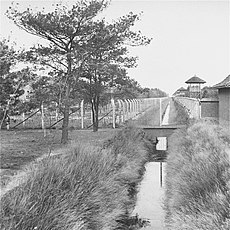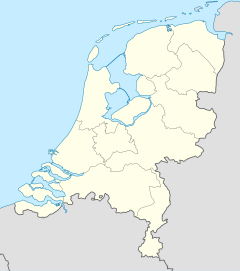KZ Herzogenbusch
| Camp Vught Konzentrationslager Herzogenbusch |
|
|---|---|
| Concentration camp | |

A view along the fences of the camp, 1945
|
|
| Coordinates | 51°39′57″N 5°15′32″E / 51.66583°N 5.25889°ECoordinates: 51°39′57″N 5°15′32″E / 51.66583°N 5.25889°E |
| Known for | 1943 – present |
| Location | Vught, Netherlands |
| Built by | Nazi Germany |
| Operated by | SS |
| Commandant |
|
| First built | 1942 |
| Operational | January 1943 26 October 1944 |
| Inmates | Jews, Gypsies political prisoners, resistance fighters, Jehovah's Witnesses, homosexuals, homeless people, black market traders, criminals, hostages |
| Killed | 749 |
| Liberated by | 4th Canadian Armored Division 96th Battery of the 5th Anti-Tank Division |
| Notable inmates | Anton Constandse, Helga Deen, David Koker |
| Notable books | Diary of David Koker Guide Camp Vught National Memorial: Final destination or transit station |
| Website | www |
Herzogenbusch concentration camp (Dutch: Kamp Vught, pronounced [kɑmp ˈfɵxt],German: Konzentrationslager Herzogenbusch [kɔntsɛntʁaˈtsi̯oːnsˌlaːɡɐ hɛʁtsoːɡənˈbʊʃ]) was a Nazi concentration camp located in Vught near the city of 's-Hertogenbosch, Netherlands. Herzogenbusch was, with Natzweiler-Struthof in occupied France, the only concentration camp run directly by the SS in western Europe outside of Germany. The camp was first used in 1943 and held 31,000 prisoners. 749 prisoners died in the camp, and the others were transferred to other camps shortly before the camp was liberated by the Allied Forces in 1944. After the war the camp was used as a prison for Germans and Dutch collaborators. Today there is a visitors' center with exhibitions and a national monument remembering the camp and its victims. The camp is now a museum.
During World War II, Nazi Germany occupied Netherlands (1940–1945). In 1942 the Nazis transported Jewish and other prisoners from the Netherlands via the transit camps Amersfoort and Westerbork to the Auschwitz concentration camp, except for 850 prisoners sent to Mauthausen concentration camp. When Amersfoort and Westerbork appeared to be too small to handle the large number of prisoners, the Schutzstaffel (SS) decided to build a concentration camp in Vught near the city of 's-Hertogenbosch.
...
Wikipedia

